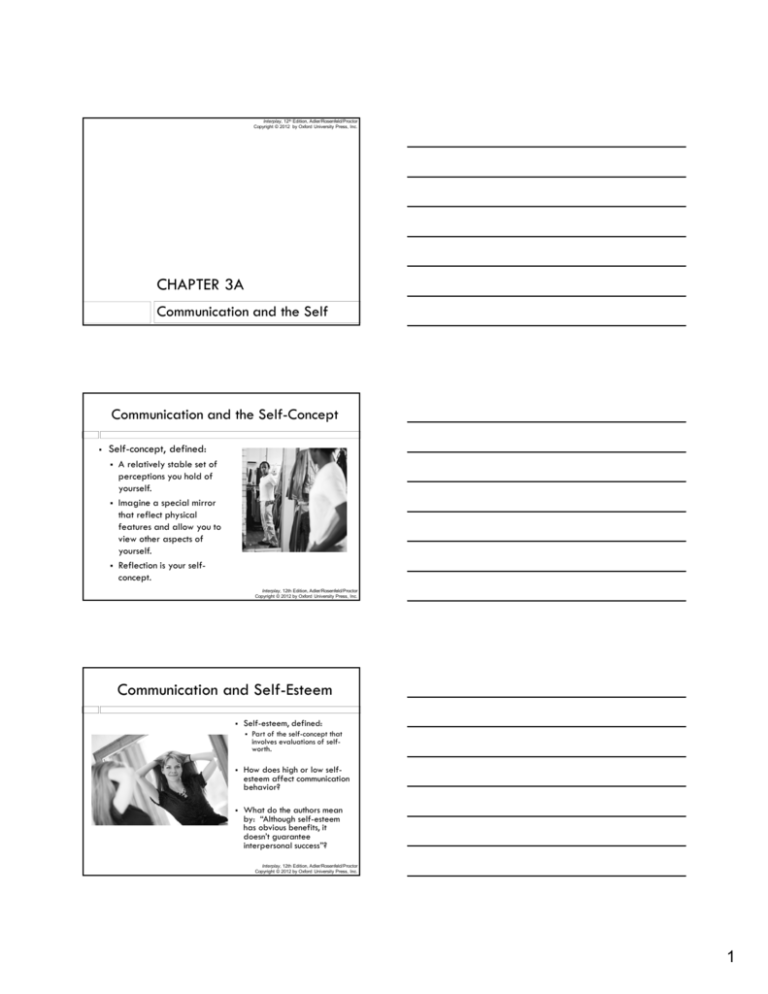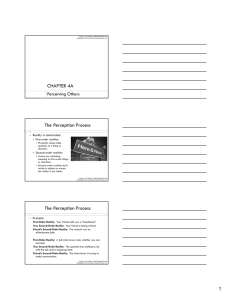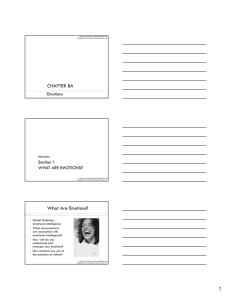CHAPTER 3A Communication and Self
advertisement

Interplay, 12th Edition, Adler/Rosenfeld/Proctor Copyright © 2012 by Oxford University Press, Inc. CHAPTER 3A Communication and the Self Communication and the Self-Concept Self-concept, defined: A relatively stable set of perceptions you hold of yourself. Imagine a special mirror that reflect physical features and allow you to view other aspects of yourself. Reflection is your selfconcept. Interplay, 12th Edition, Adler/Rosenfeld/Proctor Copyright © 2012 by Oxford University Press, Inc. Communication and Self-Esteem Self-esteem, defined: Part of the self-concept that involves evaluations of selfworth. How does high or low selfesteem affect communication behavior? What do the authors mean by: “Although self-esteem has obvious benefits, it doesn’t guarantee interpersonal success”? Interplay, 12th Edition, Adler/Rosenfeld/Proctor Copyright © 2012 by Oxford University Press, Inc. 1 How the Self-Concept Develops Reflected appraisal, defined: A mirroring of the judgments of those around you. “Significant others” are people whose evaluations are especially influential. How is the self-concept formed through reflected appraisal? What are some potential pitfalls of reflected appraisal? Interplay, 12th Edition, Adler/Rosenfeld/Proctor Copyright © 2012 by Oxford University Press, Inc. Social Comparison Social comparison, defined: Evaluating ourselves in terms of how we compare with others. Reference groups People we use to evaluate our own characteristics. How can social comparison give a person an overly positive or overly negative self-concept? Interplay, 12th Edition, Adler/Rosenfeld/Proctor Copyright © 2012 by Oxford University Press, Inc. The Self-Concept is Subjective We inflate and/or underestimate our selfperception. How may an individual’s selfperception be influenced by: obsolete information? distorted feedback? the myth of perfection? social expectations? Interplay, 12th Edition, Adler/Rosenfeld/Proctor Copyright © 2012 by Oxford University Press, Inc. 2 A Healthy Self-Concept is Flexible Why must our selfconcept change in order to stay realistic? Interplay, 12th Edition, Adler/Rosenfeld/Proctor Copyright © 2012 by Oxford University Press, Inc. The Self-Concept Resists Change Why do we resist revision of our selfperception? Cognitive conservatism, defined: Seeking information that conforms to an existing self-concept. Interplay, 12th Edition, Adler/Rosenfeld/Proctor Copyright © 2012 by Oxford University Press, Inc. Changing Our Self-Concept Four requirements: Trusting an appraisal by someone we see as competent to offer it. Appraisal must be perceived as highly personal. Appraisal must be reasonable in light of what we believe about ourselves. Appraisal must be consistent and numerous. Interplay, 12th Edition, Adler/Rosenfeld/Proctor Copyright © 2012 by Oxford University Press, Inc. 3 The Self-Fulfilling Prophecy and Communication Self-fulfilling prophecy, defined: When a person expectations of an event, and her or high subsequent behavior based on those expectations, make the outcome more likely to occur than would otherwise have true. Four stages: Holding an expectation (for yourself or for others) Behaving in accordance with that expectation The expectation coming to pass Reinforcing the original expectation Interplay, 12th Edition, Adler/Rosenfeld/Proctor Copyright © 2012 by Oxford University Press, Inc. Types of Self-Fulfilling Prophecies Type #1: Self-imposed Your own expectations influence your behavior. Research: “Communicators who believed they were incompetent proved less likely than others to pursue rewarding relationships and more likely to sabotage their existing relationships.” Type #2: When a person’s expectations govern another’s actions, whether positive or negative. “Pygmalion” effect = positive “Golem” effect = negative Observer must communicate their belief for the prediction to have an effect. Interplay, 12th Edition, Adler/Rosenfeld/Proctor Copyright © 2012 by Oxford University Press, Inc. Changing Your Self-Concept Have realistic expectations. Have a realistic perception of yourself. Have the will to change. Have the skill to change. Interplay, 12th Edition, Adler/Rosenfeld/Proctor Copyright © 2012 by Oxford University Press, Inc. 4 Interplay, 12th Edition, Adler/Rosenfeld/Proctor Copyright © 2012 by Oxford University Press, Inc. CHAPTER 3B Communication and Self-Concept, Continued… Identity Management Identity management, defined: The communication strategies people use to influence how others view them. Interplay, 12th Edition, Adler/Rosenfeld/Proctor Copyright © 2012 by Oxford University Press, Inc. Public and Private Selves Perceived self, defined: The person you believe yourself to be in moments of honest self-reflection. Unlikely to reveal this self to another person. Interplay, 12th Edition, Adler/Rosenfeld/Proctor Copyright © 2012 by Oxford University Press, Inc. 5 Public and Private Selves Presenting self, defined: An image (socially approved) we want to present to others “Facework” (Sociologist Erving Goffman) The nonverbal ways we act to maintain our own presenting images and the image of others How does Goffman’s concept of “face” relate to the presenting self? Interplay, 12th Edition, Adler/Rosenfeld/Proctor Copyright © 2012 by Oxford University Press, Inc. Characteristics of Identity Management We strive to construct multiple identities What are some different contexts or situations in which you may construct different identities? Explain whether or not a person can present different identities simultaneously. Interplay, 12th Edition, Adler/Rosenfeld/Proctor Copyright © 2012 by Oxford University Press, Inc. Characteristics of Identity Management Identity management is collaborative “Process theater” in which we improvise scenes where our character reacts with others. What happens when someone rejects or does not collaborate with our identity management attempts? Interplay, 12th Edition, Adler/Rosenfeld/Proctor Copyright © 2012 by Oxford University Press, Inc. 6 Characteristics of Identity Management Identity management can be deliberate or unconscious What situations would require deliberate identity management? We unconsciously act in small public performances, making a particular facial expression or using a particular tone of voice. Interplay, 12th Edition, Adler/Rosenfeld/Proctor Copyright © 2012 by Oxford University Press, Inc. Characteristics of Identity Management People differ in their degrees of identity management What are advantages to being a high self-monitor? Drawbacks? Interplay, 12th Edition, Adler/Rosenfeld/Proctor Copyright © 2012 by Oxford University Press, Inc. Why Manage Impressions? Social rules Personal goals Relational goals It is impossible not to create impressions Interplay, 12th Edition, Adler/Rosenfeld/Proctor Copyright © 2012 by Oxford University Press, Inc. 7 How Do We Manage Impressions? Face-to-face impression management Manner Words Nonverbal actions Appearance Personal items people use to shape an image Clothing Hairstyle Personal affects Setting Physical items people use to influence how others view them “Artifacts” decorate the space we live in Automobiles Artwork Interplay, 12th Edition, Adler/Rosenfeld/Proctor Copyright © 2012 by Oxford University Press, Inc. Identity Management in Mediated Communication Mediated communication “One of the interesting things about the Internet is the opportunity it offers people to present themselves in a variety of different ways.” In mediated identity management, how do the factors of manner, appearance, and setting change? How do these changes make it easier or more difficult to manage identity? Interplay, 12th Edition, Adler/Rosenfeld/Proctor Copyright © 2012 by Oxford University Press, Inc. Identity Management and Honesty People sometimes misrepresent themselves to gain the trust of others. What are examples of ethical or honest identity management? Not only one honest way to behave in every circumstance. Impression management involves deciding which face—which part of yourself—to reveal. Interplay, 12th Edition, Adler/Rosenfeld/Proctor Copyright © 2012 by Oxford University Press, Inc. 8 Choosing What to Reveal Self-disclosure Every verbal or nonverbal behavior we engage in is self-revealing Distinguishing factors of self-disclosure: Honesty Depth Availability of information Context of sharing Interplay, 12th Edition, Adler/Rosenfeld/Proctor Copyright © 2012 by Oxford University Press, Inc. Models of Self-Disclosure Degrees of Self-Disclosure: The Social Penetration Model (Altman and Taylor) Two dimensions: Breadth of information volunteered Depth of information volunteered Altman and Taylor: “the development of a relationship as a progression from the periphery … to its center. Process occurs over time.” Types of information revealed: Clichés—ritualized, stock responses to social situations Facts Opinions Feelings Interplay, 12th Edition, Adler/Rosenfeld/Proctor Copyright © 2012 by Oxford University Press, Inc. Models of Self-Disclosure Note from Ellen: I would insert the graphic of this model here… LL1 Interplay, 12th Edition, Adler/Rosenfeld/Proctor Copyright © 2012 by Oxford University Press, Inc. 9 Slide 27 LL1 graphic needed Laura Lawrie, 12/16/2011 Awareness of Self-Disclosure: The Johari Window Model Johari Window (Luft and Ingham) Frame contains likes, dislikes, goals, secrets, needs. Part 1: Open area; information of which both you and the other person are aware. Part 2: Blind area; information of which you are unaware, but the other person knows. Part 3: Hidden area; information that you know, but aren’t willing to reveal to others. Part 4: Unknown area: information unknown to you and others. Interplay, 12th Edition, Adler/Rosenfeld/Proctor Copyright © 2012 by Oxford University Press, Inc. Models of Self-Disclosure Note from Ellen: I would insert the graphic of this model here… LL2 Interplay, 12th Edition, Adler/Rosenfeld/Proctor Copyright © 2012 by Oxford University Press, Inc. Benefits of Self-Disclosure Catharsis Self-clarification Self-validation Reciprocity Impression formation Relationship maintenance and enhancement Moral obligation Social influence Self-defense Interplay, 12th Edition, Adler/Rosenfeld/Proctor Copyright © 2012 by Oxford University Press, Inc. 10 Slide 29 LL2 needs graphic Laura Lawrie, 12/16/2011 Risks of Self-Disclosure Rejection Negative impression Decrease in relational satisfaction Loss of influence Loss of control Hurt the other person Interplay, 12th Edition, Adler/Rosenfeld/Proctor Copyright © 2012 by Oxford University Press, Inc. Guidelines for Self Disclosure Is the other person important to you? Is the risk of disclosing reasonable? Is the self-disclosure appropriate? Is the disclosure reciprocated? Will the effect be constructive? Interplay, 12th Edition, Adler/Rosenfeld/Proctor Copyright © 2012 by Oxford University Press, Inc. Alternatives to Self-Disclosure Silence Lying Benevolent lies, unmalicious Told for the benefit of the recipient Equivocation Equivocal language: Two or more plausible meanings Used for face-saving Can save a speaker from being caught lying Hinting Face-saving Interplay, 12th Edition, Adler/Rosenfeld/Proctor Copyright © 2012 by Oxford University Press, Inc. 11 The Ethics of Evasion Provides a way to manage difficult situations There are times when honesty is the right approach, even when painful Consider: Are the effects of a lie worth the deception? Is the indirect message in the interest of the receiver? Is evasion the only way to behave? How would others respond if they knew what you were really thinking/feeling? Interplay, 12th Edition, Adler/Rosenfeld/Proctor Copyright © 2012 by Oxford University Press, Inc. 12









